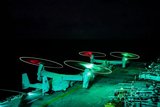DTC introduces Maritime Mesh
Domo Tactical Communications (DTC) has introduced a new high capacity wireless IP mesh communications solution for the maritime environment called Maritime Mesh, the company announced on 16 December.
The solution has been developed to overcome the challenges of operating high bandwidth microwave systems in maritime operations. Where they exist, communications links are expensive and often unreliable or insecure, making operations which rely on critical communications – such as maritime interdiction – difficult to achieve.
Maritime Mesh offers non-line-of-sight (NLOS) properties for the secure and seamless exchange of data, providing users the ability to stream live HD video and audio, beyond-line-of-site (BLOS) with the use of autonomous surface vehicles (ASVs) and unmanned aerial vehicles (UAVs) equipped with DTCs Maritime IP Mesh system.
The system uses COFDM RF technology to create a self-healing, self-forming, and extensive IP network that works with IP backhaul infrastructure to provide ultra NLOS penetration, including on-board/inside vessels.
The resulting high-speed, high-capacity system can be used for maritime applications, including maritime boarding operations, military forces, rescue organisations, industrial vessels and mining and energy companies.
Nigel Lee, regional sales director EMEA said: ‘In addition to the powerful, seamless connectivity it provides, the beauty of Maritime Mesh is its compact, unobtrusive size. It can be easily fixed to external structures, or can be man portable, and is appropriately designed to withstand the elements utilising IP67 rated enclosures and marine grade materials. In short, it can take anything you throw at it and still perform its mission.’
DTC Mesh products create a mesh network as soon as power is applied, which allows for permanent or temporary deployment onto vessels, air assets, personnel or land-based stations without the requirement for additional infrastructure. Data sharing between USV, UAV, and mother ship, which then uses IP back-hauling via SATCOM technology to HQ, provides sight where it would previously have been impossible.
More from Digital Battlespace
-
![Babcock nears first customer for Nomad AI translation tool]()
Babcock nears first customer for Nomad AI translation tool
Nomad can provide militaries with real-time intelligence, saving critical time on the battlefield.
-
![AUSA 2025: Israel’s Asio Technologies to supply hundreds of improved Taurus tactical systems]()
AUSA 2025: Israel’s Asio Technologies to supply hundreds of improved Taurus tactical systems
Taurus operates alongside the Israel Defense Forces’ Orion system which supports mission management across tens of thousands of manoeuvring forces, from squad leaders to battalion commanders.
-
![AUSA 2025: Kopin pushes micro-LED plans as China moves faster]()
AUSA 2025: Kopin pushes micro-LED plans as China moves faster
The plan for the new displays follows fresh investment in Kopin’s European facilities by Theon and an order for head-up displays in fielded aircraft, with funding from the US Department of Defense.
-
![AUSA 2025: Persistent Systems to complete its largest order by year’s end]()
AUSA 2025: Persistent Systems to complete its largest order by year’s end
Persistent Systems received its largest ever single order for its MPU5 devices and other systems earlier this month and has already delivered the 50 units to the US Army’s 4th Infantry Division.
-
![Aselsan brings in dozens of companies and systems under the Steel Dome umbrella]()
Aselsan brings in dozens of companies and systems under the Steel Dome umbrella
Turkey has joined the family of countries attempting to establish a multilayered air defence system with government approval in August 2024 for the effort landed by Aselsan. Dubbed Steel Dome, the programme joins Israel’s Iron Dome, the US Golden Dome, India’s Mission Sudarshan Chakra and South Korea’s low-altitude missile defence system.
-
![DSEI 2025: MARSS unveils new agnostic multidomain C4 system]()
DSEI 2025: MARSS unveils new agnostic multidomain C4 system
MARSS’ NiDAR system has been deployed using sensors from static platforms to provide detection and protection for static sights, such as critical infrastructure, ports and military bases.

























